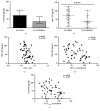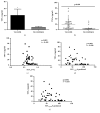Association of Elevated Serum GM-CSF, IFN- γ, IL-4, and TNF- α Concentration with Tobacco Smoke Induced Chronic Obstructive Pulmonary Disease in a South Indian Population
- PMID: 30155241
- PMCID: PMC6092978
- DOI: 10.1155/2018/2027856
Association of Elevated Serum GM-CSF, IFN- γ, IL-4, and TNF- α Concentration with Tobacco Smoke Induced Chronic Obstructive Pulmonary Disease in a South Indian Population
Abstract
Background: Chronic obstructive pulmonary disease (COPD) is a devastating condition with limited pharmacotherapeutic options and exceptionally high public-health burden globally as well as in India. Tobacco smoking is the primary cause for COPD among men in India. Systemic inflammation involving altered regulation of cytokines controlling the host defense mechanism is a hallmark of COPD pathogenesis. However, biomarker discovery studies are limited among Indian COPD patients.
Methods: We assessed the serum concentrations [median (25th-75th percentile) pg/ml] of interleukin (IL)-2,4,6,8,10, granulocyte macrophage colony stimulating factor (GM-CSF), interferon gamma (IFN-γ), and tumor necrosis factor alpha (TNF-α) using a multiplexed immunoassay. Our study cohort consisted of 30 tobacco smokers with COPD (TS COPD) and 20 tobacco smokers without COPD (TS CONTROL) from South India. The study population was matched for age, sex (male), and tobacco consumption (pack-years). COPD was diagnosed according to the global initiative for chronic obstructive lung disease (GOLD) criteria of persistent airflow obstruction determined by the ratio of postbronchodilator forced expiratory volume in 1 second/forced vital capacity (FEV1/FVC) of <0.7. A validated structured questionnaire-based survey [Burden of Obstructive Lung Disease (BOLD) study] and spirometry were performed during house to house visit of the field study. Statistical analysis included nonparametric (two-tailed) Mann-Whitney U and Spearman rank test, as appropriate (significance: p<0.05).
Results: Serum GM-CSF [69.64 (46.67, 97.48); 36.78 (30.07, 53.88), p=0.014], IFN-γ [51.06 (17.00, 84.86); 11.70 (3.18, 32.81), p=0.017], IL-4 [9.09 (1.8, 19.9); 1.8 (1.8, 4.46); p=0.024], and TNF-α [20.68 (5.5, 29.26); 3.5 (3.5, 4.5); p<0.001] concentrations (pg/ml) were increased in TS COPD subjects compared to TS CONTROL. A weak correlation between lung function parameters and cytokine concentrations was detected.
Conclusion: Our pilot study reveals GM-CSF, IFN-γ, IL-4, and TNF-α as plausible COPD susceptibility biomarkers within the investigated South Indian population that needs to be validated in a larger cohort.
Figures




Similar articles
-
Putative Systemic Biomarkers of Biomass Smoke-Induced Chronic Obstructive Pulmonary Disease among Women in a Rural South Indian Population.Dis Markers. 2018 Nov 22;2018:4949175. doi: 10.1155/2018/4949175. eCollection 2018. Dis Markers. 2018. PMID: 30595762 Free PMC article.
-
Cytokine profile in the sputum of subjects with post-tuberculosis airflow obstruction and in those with tobacco related chronic obstructive pulmonary disease.BMC Immunol. 2020 Oct 1;21(1):52. doi: 10.1186/s12865-020-00381-w. BMC Immunol. 2020. PMID: 32998687 Free PMC article.
-
Correlation of severity of chronic obstructive pulmonary disease with potential biomarkers.Immunol Lett. 2018 Apr;196:1-10. doi: 10.1016/j.imlet.2018.01.004. Epub 2018 Jan 9. Immunol Lett. 2018. PMID: 29329680
-
Impact of active and passive smoking as risk factors for asthma and COPD in women presenting to primary care in Syria: first report by the WHO-GARD survey group.Int J Chron Obstruct Pulmon Dis. 2013;8:473-82. doi: 10.2147/COPD.S50551. Epub 2013 Oct 2. Int J Chron Obstruct Pulmon Dis. 2013. PMID: 24124359 Free PMC article.
-
The pharmacological management of asthma-chronic obstructive pulmonary disease overlap syndrome (ACOS).Expert Opin Pharmacother. 2020 Feb;21(2):213-231. doi: 10.1080/14656566.2019.1701656. Expert Opin Pharmacother. 2020. PMID: 31955671 Review.
Cited by
-
A case-control study of tumor necrosis factor-alpha promoter polymorphism and its serum levels in patients with chronic obstructive pulmonary disease in Kashmir, North India.Lung India. 2020 May-Jun;37(3):204-209. doi: 10.4103/lungindia.lungindia_477_19. Lung India. 2020. PMID: 32367841 Free PMC article.
-
Altered levels of IFN-γ, IL-4, and IL-5 depend on the TLR4 rs4986790 genotype in COPD smokers but not those exposed to biomass-burning smoke.Front Immunol. 2024 Jul 30;15:1411408. doi: 10.3389/fimmu.2024.1411408. eCollection 2024. Front Immunol. 2024. PMID: 39139567 Free PMC article.
-
The Antioxidant MitoQ Protects Against CSE-Induced Endothelial Barrier Injury and Inflammation by Inhibiting ROS and Autophagy in Human Umbilical Vein Endothelial Cells.Int J Biol Sci. 2019 Jun 2;15(7):1440-1451. doi: 10.7150/ijbs.30193. eCollection 2019. Int J Biol Sci. 2019. PMID: 31337974 Free PMC article.
-
Zhuye Shigao Decoction Combined with Qingqi Huatan Pills in Alleviating the Acute Exacerbation of Chronic Obstructive Pulmonary Disease (Phlegm-Heat Stagnating in the Lungs) via the IL-6-Mediated JAK1/STAT3 Signaling Pathway.Evid Based Complement Alternat Med. 2022 May 6;2022:7942623. doi: 10.1155/2022/7942623. eCollection 2022. Evid Based Complement Alternat Med. 2022. PMID: 35571736 Free PMC article.
-
Endothelial function and T-lymphocyte subsets in patients with overlap syndrome of chronic obstructive pulmonary disease and obstructive sleep apnea.Chin Med J (Engl). 2019 Jul 20;132(14):1654-1659. doi: 10.1097/CM9.0000000000000312. Chin Med J (Engl). 2019. PMID: 31283649 Free PMC article.
References
-
- Salvi S., Agarwal A. India needs a national COPD prevention and Control program. Journal of the Association of Physicians of India. 2012;60:5–7. - PubMed
-
- Vogelmeier C. F., Criner G. J., Martinez F. J., et al. Global strategy for the diagnosis, management and prevention of chronic obstructive lung disease 2017 report: GOLD executive summary. American Journal of Respiratory and Critical Care Medicine. 2017;195(5):557–582. doi: 10.1164/rccm.201701-0218PP. - DOI - PubMed
LinkOut - more resources
Full Text Sources
Other Literature Sources

